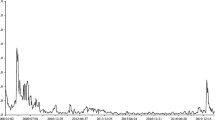Abstract
This paper investigates the relationship between monetary policy and the stock market using weekly U.S. data, following the work of Serletis and Istiak (2016). In doing so, vector autoregression (VAR) is adopted, and we allow rich interdependence between monetary policy and the stock market. The model is identified by exploiting the conditional heteroscedasticity of the reduced form VAR error terms. Two structural shocks – money demand and supply shocks – are extracted. The findings show a positive money demand shock, which increases the interest rate, decreases the stock price. On the other hand, a positive money supply shock does not significantly increase the stock price. We find that the impulse responses of stock prices are symmetric in positive and negative money supply shocks. It follows that money supply shocks do not have asymmetric effects on the stock market in general.



Similar content being viewed by others
References
Angrist JD, Jordá Ó, Kuersteiner G (2018) Semiparametric estimates of monetary policy effects: string theory revisited. J Bus Econ Stat 36:371–387
Bernanke BS, Mihov I (1998) Measuring monetary policy. Quart J Econ 113:869–902
Bernanke BS, Kuttner KN (2005) What explains the stock market’s reaction to Federal Reserve policy? J Financ 60:1221–1257
Bjørnland HC, Leitemo K (2009) Identifying the interdependence between US monetary policy and the stock market. J Monet Econ 56:275–282
Bouakez H, Essid B, Normandin M (2013) Stock returns and monetary policy: Are there any ties? J Macroecon 36:33–50
Chen S (2007) Does monetary policy have asymmetric effects on stock returns? J Money, Credit, Bank 39:667–688
Cover JP (1992) Asymmetric effects of positive and negative money-supply shocks. Quart J Econ 107:1261–1282
Ehrmann M, Fratzscher M (2004) Taking stock: monetary policy transmission to equity markets. J Money, Credit, Bank 36:719–737
Engle R (1982) Autoregressive conditional heteroscedasticity with estimates of the variance of united kingdom inflation. Econometrica 50:987–1007
Favara G, Giordani P (2009) Reconsidering the role of money for output, prices and interest rates. J Monet Econ 56:419–430
Gogas P, Pragidis I, Tabak BM (2018) Asymmetric effects of monetary policy in the U.S and Brazil. J Econ Asymmetries 18:e00108
Karras G (1996) Are the output effects of monetary policy asymmetric? Evidence from a sample of European countries. Oxford Bull Econ Stat 58:267–278
Kilian L, Vigfusson RJ (2011) Are the responses of the U.S. economy asymmetric in energy price increases and decreases? Quant Econ 2:419–453
Kilian L, Lütkepohl H (2017) Structural Vector Autoregressive Analysis. Cambridge University Press, Cambridge
Koop G, Pesaran MH, Potter SM (1996) Impulse response analysis in nonlinear multivariate models. J Econ 74:119–147
Li J (2015) The asymmetric effects of investor sentiment and monetary policy on stock prices. Appl Econ 47:2514–2522
Neely CJ (2004) The federal reserve responds to crises: September 11th was not the first. Federal Reserve Bank of St. Louis. Review 86:27–42
Normandin M, Phaneuf L (2004) Monetary policy shocks: Testing identification conditions under time-varying conditional volatility. J Monet Econ 51:1217–1243
Pearce DK, Roley VV (1983) The reaction of stock prices to unanticipated changes in money: A note. J Financ 38:1323–1333
Rigobon R, Sack B (2003) Measuring the reaction of monetary policy to the stock market. Quart J Econ 118:639–669
Rigobon R, Sack B (2004) The impact of monetary policy on asset prices. J Monet Econ 51:1553–1575
Sellin P (2001) Monetary policy and the stock market: theory and empirical evidence. J Econ Surv 15:491–541
Serletis A, Istiak K (2016) Are the responses of the U.S. economy asymmetric to positive and negative money supply shocks? Open Econ Rev 27:303–316
Thorbecke W (1997) On stock market returns and monetary policy. J Financ 52:635–654
Thornton DL (2006) When did the FOMC begin targeting the federal funds rate? What the verbatim transcripts tell Us. J Money, Credit, Bank 38:2039–2071
Tobin J (1969) A general equilibrium approach to monetary theory. J Money, Credit, Bank 1:15–29
Tobin J (1978) Monetary policy and the economy: the transmission mechanism. South Econ J 44:421–431
Acknowledgements
We would like to thank the Editor and an anonymous referee for comments that greatly improved the paper.
Author information
Authors and Affiliations
Corresponding author
Ethics declarations
Disclosure Statement
The authors declared that they have no conflict of interest.
Additional information
Publisher’s Note
Springer Nature remains neutral with regard to jurisdictional claims in published maps and institutional affiliations.
Supplementary Information
Below is the link to the electronic supplementary material.
Rights and permissions
Springer Nature or its licensor (e.g. a society or other partner) holds exclusive rights to this article under a publishing agreement with the author(s) or other rightsholder(s); author self-archiving of the accepted manuscript version of this article is solely governed by the terms of such publishing agreement and applicable law.
About this article
Cite this article
Song, V., Xu, L. Do Monetary Policy Shocks Have Asymmetric Effects on Stock Market?. Open Econ Rev 34, 1063–1078 (2023). https://doi.org/10.1007/s11079-022-09710-5
Accepted:
Published:
Issue Date:
DOI: https://doi.org/10.1007/s11079-022-09710-5




